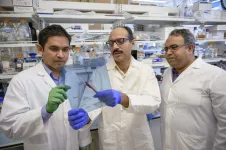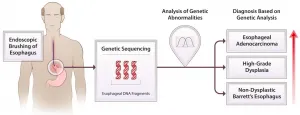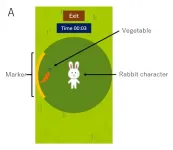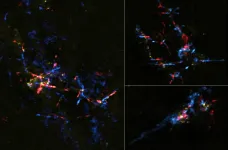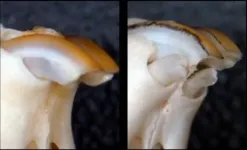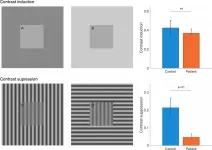(Press-News.org) SPOKANE, Wash. - New research led by scientists at Washington State University has found that a protein known as GBP5 appears to play a key role in suppressing inflammation in rheumatoid arthritis, a potentially debilitating disease in which the immune system mistakenly attacks the body's own joint tissues.
Published in the journal Arthritis & Rheumatology, the discovery could someday lead to new treatments to slow or halt the progress of the disease, which affects an estimated 1.5 million Americans. The researchers said it may also have applications in other inflammatory diseases.
First author Mahamudul Haque first stumbled upon GBP5 back in 2015, when he was working toward a Ph.D. in pharmaceutical sciences in WSU's College of Pharmacy and Pharmaceutical Sciences. Now a postdoctoral research associate in the WSU Elson S. Floyd College of Medicine, Haque had been tasked with comparing the expression of different genes in joint tissue from rheumatoid arthritis patients and non-diseased joint tissue. Among the thousands of genes included in his analysis, one gene stood out in particular because its expression level was several times greater in rheumatoid arthritis tissue. That gene was guanylate binding protein 5 (GBP5), which helps produce the GBP5 protein.
"That caught our attention and interest," said senior author Salah-Uddin Ahmed, a professor in the College of Pharmacy and Pharmaceutical Sciences who oversaw the work.
As far as Ahmed and Haque could tell, no other studies had looked at the role of GBP5 in rheumatoid arthritis or other auto-immune diseases, so they decided to take on the task.
The inflammation seen in rheumatoid arthritis causes painful swelling of joint tissues that can result in bone loss and deformed joints. Previous research conducted by Ahmed and his team has suggested that this inflammation is driven primarily by a cytokine protein known as interleukin-1 beta (IL-1 beta). To find out what role GBP5 plays, the researchers designed a series of experiments using rheumatoid arthritis synovial fibroblasts, a type of cell located in the tissue that lines joints and is known to play a role in inflammation and joint destruction. When they manipulated the cells to stop producing GBP5 and then added IL-1 beta to induce inflammation, they saw much higher levels of inflammation in cells that lacked GBP5 versus in non-manipulated cells. What's more, when they increased levels of GBP5 in those same cells, inflammation triggered by IL-1 beta went down.
"Our initial thought had been that the GBP5 protein played a role in causing the disease, but as we worked to decipher the mechanism of GBP5 in rheumatoid arthritis we found that it was induced in response to inflammation and was trying to cut back inflammation before it goes out of control," Ahmed said.
In addition, their research revealed how GBP5 interacts with interferon gamma, another cytokine that has been shown to fight inflammation under certain circumstances. When they silenced the GBP5 gene, the researchers found that it reduced interferon gamma's ability to fight the inflammation triggered by IL-1 beta. This suggests that, on top of having its own anti-inflammatory effect, GBP5 also supports the anti-inflammatory function of interferon gamma.
Finally, the researchers confirmed their findings in a rodent model of rheumatoid arthritis, which showed that joint inflammation and bone loss increased when the GBP5 gene was turned off.
Ahmed said he and his team are conducting additional research to confirm that their findings hold up in other pre-clinical models of rheumatoid arthritis. Pending further, clinical studies to test this concept in rheumatoid arthritis patients at different stages of the disease, Ahmed said their findings could someday lead to the development of new combination therapies that could boost GBP5 levels to reduce inflammation and bone loss.
"What we would like to understand is, if we introduced this protein very early during the onset of rheumatoid arthritis, could we reverse or suppress the course of the disease?" Ahmed said.
Haque also suggested that researchers should take a closer look at the role of GBP5 in other conditions that involve inflammation. This includes other types of arthritis, such as gout and osteoarthritis.
INFORMATION:
In addition to Haque and Ahmed, authors on the paper include Anil K. Singh--an assistant research professor in the Ahmed lab at WSU --and Madhu Ouseph, a pathologist who was at the Stanford University School of Medicine and is now at Weill Cornell Medical College.
Funding for the study came from the National Institute of Arthritis and Musculoskeletal and Skin Diseases of the National Institutes of Health under award number R01AR072615 and from internal funds provided by Washington State University. Support for the initial findings that laid the groundwork for this study came from the Rheumatology Research Foundation.
A combination of esophageal brushing and extensive genetic sequencing of the sample collected can detect chromosome alterations in people with Barrett's Esophagus, identifying patients at risk for progressing to esophageal cancer, according to a new study by researchers at the Johns Hopkins Kimmel Cancer Center and Case Western Reserve University.
In Barrett's Esophagus (BE), chronic acid reflux from the stomach damages the cells lining the lower esophagus, causing them to become more like cells of the lower digestive system. Cells in the lower esophagus progress through several precancerous stages before sometimes developing into esophageal adenocarcinoma, a cancer with a five-year survival rate below 20 percent. BE is the only known precursor to esophageal adenocarcinoma.
Clinicians ...
EU imports of products including palm oil, soybeans, and beef contribute significantly to deforestation in other parts of the world. In a new study, researchers from Chalmers University of Technology, Sweden, and the University of Louvain, Belgium, evaluated over a thousand policy proposals for how the EU could reduce this impact, to assess which would have the largest potential to reduce deforestation - while also being politically feasible.
"Unsurprisingly, there is weaker support for tougher regulations, such as import restrictions on certain goods. But our study shows that there is broad support in general, ...
New genetic analysis and years of painstaking research has revealed that one of the world's most endangered marine mammals is actually two species rather than one, as scientists had long assumed.
Scientists spent about two decades crossing Asia and Europe in pursuit of river dolphins skulls and reexamining tissue samples with modern genetic techniques. Their findings revealed that Indus and Ganges river dolphins are separate species, according to a new study published in Marine Mammal Science.
The two dolphins that live in the muddy waters ...
SINGAPORE, 29 March 2021 - A low-cost intervention to improve hypertension--or high blood pressure (BP)--prevention and management can be cost-effectively scaled up for rural communities in low- and middle-income countries, according to findings from a multi-country trial published in The Lancet Global Health.
Led by Duke-NUS Medical School in Singapore, the Control of Blood Pressure and Risk Attenuation--Bangladesh, Pakistan, Sri Lanka (COBRA-BPS) trial, conducted in partnership with the International Centre for Diarrhoeal Diseases Research, Bangladesh (ICDDR,B), Aga Khan University in Pakistan, the University of Kelaniya in Sri Lanka, analysed the budget impact and cost-effectiveness ...
A Japanese research group combined motion analysis that uses smartphone application and machine learning that uses an anomaly detection method, thereby developing a technique to easily screen for carpal tunnel syndrome. Carpal tunnel syndrome is common amongst middle-aged women. The disease causes compressed nerves in the wrist, causing numbness and difficulty with finger movements. While an accurate diagnosis can be reached with nerve conduction study, this is not widely used because it requires expensive devices and specialized skills. Thus, a simple screen tool that does ...
Astronomers found a number of stellar eggs containing baby stars around the center of the Milky Way using the Atacama Large Millimeter/submillimeter Array (ALMA). Previous studies had suggested that the environment there is too harsh to form stars. These findings indicate that star formation is more resilient than researchers thought.
Stars form in stellar eggs, cosmic clouds of gas and dust which collapse due to gravity. If something interferes with the gravity driven contraction, star formation will be suppressed. There are many potential sources of interference near the Galactic Center. Strong turbulence can stir up the clouds ...
Japan -- The tooth fairy is a welcome guest for any child who has lost a tooth. Not only will the fairy leave a small gift under the pillow, but the child can be assured of a new tooth in a few months. The same cannot be said of adults who have lost their teeth.
A new study by scientists at Kyoto University and the University of Fukui, however, may offer some hope. The team reports that an antibody for one gene -- uterine sensitization associated gene-1 or USAG-1 -- can stimulate tooth growth in mice suffering from tooth agenesis, a congenital condition. The paper was published in Science Advances.
Although the normal adult mouth has 32 teeth, about ...
A group of researchers from Russia, Germany, the Czech Republic, and Switzerland contest the common belief that resource-based economies have higher levels of within-country inequality than resource-scarce economies. The researchers document a direct causal link between natural resources and within-country inequality and conclude that the extraction of oil and gas can reduce inequality or has no significant effect on it. The results were published in the journal Empirical Economics.
"When we compare the natural resource rents to GDP 10 years after the discovery of natural ...
Researchers specialised in psychiatry and psychology at the University of Helsinki investigated the effects of depression on visual perception. The study confirmed that the processing of visual information is altered in depressed people, a phenomenon most likely linked with the processing of information in the cerebral cortex.
The study was published in the Journal of Psychiatry and Neuroscience.
In the study, the processing of visual information by patients with depression was compared to that of a control group by utilising two visual tests. In the perception tests, the study subjects compared the brightness and contrast of simple patterns.
"What ...
Pedestrian movements are tricky to track, but now the first large-scale statistical analysis of pedestrian flow using anonymous phone data collected in three European capital cities, London, Amsterdam and Stockholm, has been conducted by researchers from KAUST with Swedish colleagues from Gothenburg.
Analyzing the flow of pedestrians through city streets provides insights into how city design influences walking behavior. Studies of pedestrian flow inform new urban developments, enable designers to define quieter areas and "urban buzz" zones and reveal how spaces are used at different times.
"In a previous study, we found strong links between the total ...
